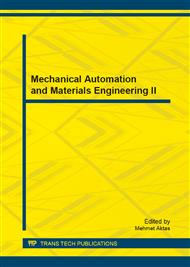p.41
p.45
p.49
p.57
p.62
p.71
p.79
p.87
p.92
Studies on the Residual Stress Distribution for 2A02 Aluminum Forgings
Abstract:
High strength aluminum alloys which improve mechanical properties through heat treatment have been widely used in aviation manufacturing. However, residual stresses that are harmful to the materials are brought in during the heat treatment process. By means of the analysis of micro-indentation method and ANSYS finite element method, the residual stress distribution in 2A02aluminum forgings after water quenching were systematically investigated, mainly considering two factors of the symmetry of structure and the variation of surface constraint. The results of micro-indentation method show that the absolute value of the residual stress within the sample tends to decrease as the condition of constraint increase at the location of the same thickness; the absolute value of the surface residual stress also tends to decrease as the thickness of the sample increase with the same constraint conditions, the absolute value of the residual stress in the symmetrical sample is lower than that in the asymmetrical sample. The results of finite element simulation are as follows: for 2A02 aluminum alloy, the stress field distribution during the process of quenching is mainly influenced by the thickness of the samples. After the quenching process, the stress state at the components surface are controlled by compressive stress in the direction of both thickness and width, while the residual stress within the samples is dominated by tensile stress.
Info:
Periodical:
Pages:
62-70
Citation:
Online since:
June 2014
Authors:
Price:
Сopyright:
© 2014 Trans Tech Publications Ltd. All Rights Reserved
Share:
Citation:


